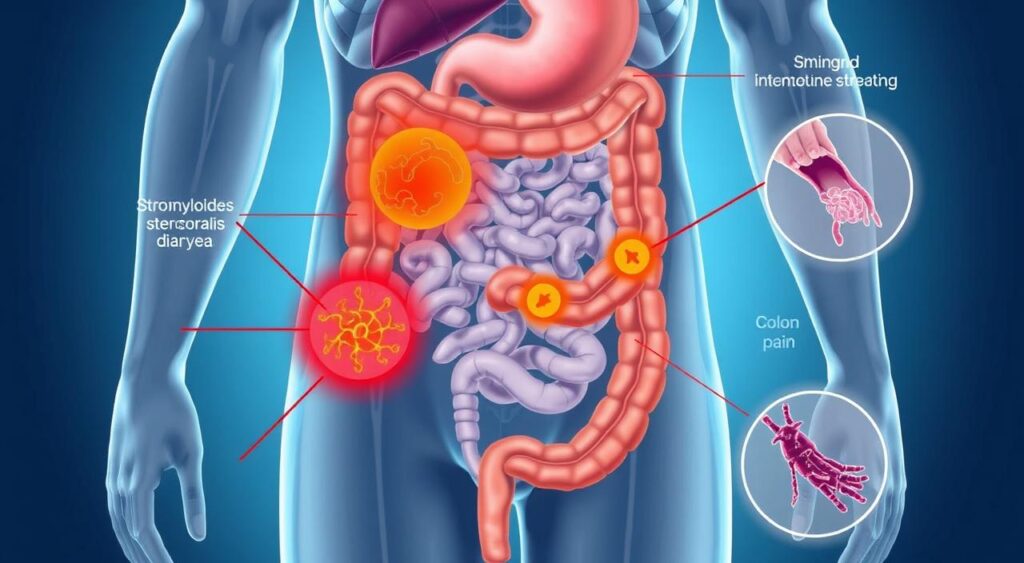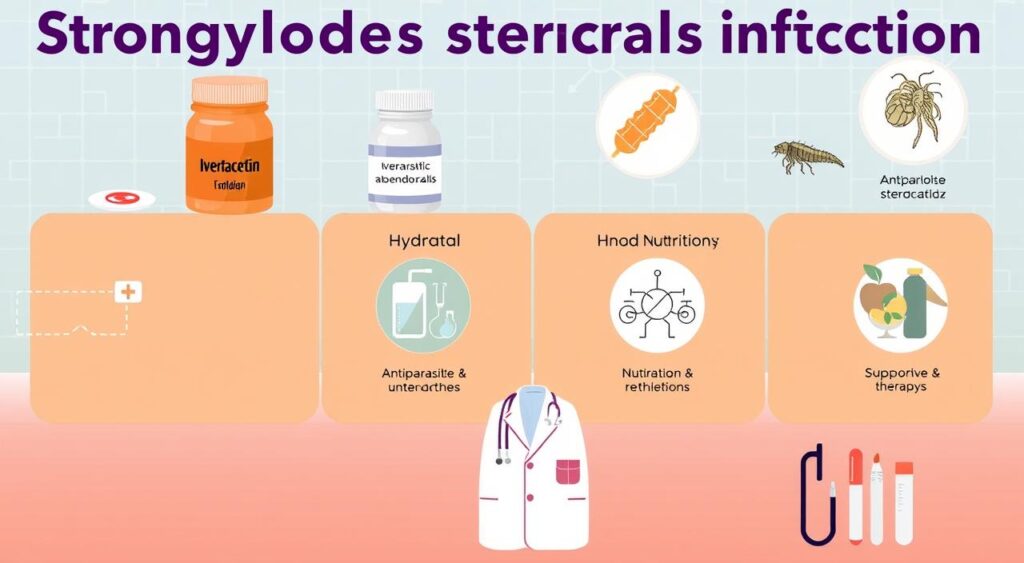Explore the symptoms, causes, and treatments of Strongyloides Stercoralis, a parasitic infection that can cause serious health issues.
Worldwide, 100 million people are infected with strongyloides stercoralis, a type of threadworm. It can cause symptoms from mild stomach issues to serious health problems. This infection is a big concern for public health, especially in warm and humid areas.
Strongyloides stercoralis is a parasitic infection that affects human health deeply. It’s important to know its symptoms, causes, and how to treat it.

Key Takeaways
- Strongyloides stercoralis is a type of threadworm that can infect humans and cause a range of symptoms.
- This helminth infection can have severe complications if left untreated.
- Understanding the symptoms and causes of strongyloides stercoralis is crucial for effective treatment and prevention.
- Strongyloides stercoralis is a significant public health concern, particularly in tropical and subtropical regions.
- Treatment options are available for strongyloides stercoralis, and early diagnosis is essential for effective management.
- Prevention strategies, such as personal hygiene practices and environmental control, can help reduce the risk of infection.
Understanding Strongyloides Stercoralis and Its Impact
Strongyloides stercoralis is a parasitic nematode that infects humans. It causes various symptoms. This infection is found worldwide. Knowing about this parasite and its effects on the body is key.
This parasite can lead to stomach pain and diarrhea. It can also cause larva currens, where larvae move quickly under the skin. This leads to itching and skin irritation.
What is Strongyloides Stercoralis?
Strongyloides stercoralis is a parasitic nematode that infects humans. It spreads through skin contact with contaminated soil. Its life cycle includes several stages, including the larval stage.
Global Distribution and Prevalence
Strongyloides stercoralis is found globally, especially in tropical and subtropical areas. The infection rate varies. This is due to poor sanitation and hygiene.
Life Cycle of the Parasite
The life cycle of Strongyloides stercoralis includes egg, larval, and adult stages. It can complete its cycle inside a human, leading to autoinfection and persistent infection.
Understanding the parasite’s life cycle is vital. It helps in developing effective treatments and prevention strategies. Knowing the stages helps healthcare professionals target treatment and reduce complications like stomach issues and larva currens.
The Biology of Strongyloides Stercoralis Infection
The biology of Strongyloides Stercoralis infection is complex. It involves a chronic infection cycle that can last for years. This cycle leads to a variety of symptoms, from mild stomach issues to serious health problems. Knowing how the infection works is key to finding good treatments and ways to prevent it.
The autoinfection cycle is a major part of the infection. It allows the parasite to keep infecting the host, leading to a never-ending cycle. This makes treatment hard. The infection’s chronic nature means it can cause ongoing health issues, making it important to find ways to manage and prevent it.
Important factors in the biology of Strongyloides Stercoralis infection include:
- The parasite’s life cycle and how it infects the host
- The symptoms and complications that can arise from the infection
- The importance of breaking the autoinfection cycle to prevent persistent infection
Understanding the biology of Strongyloides Stercoralis infection is crucial. It helps healthcare professionals create effective treatments and prevention strategies. This way, they can better manage and control the infection.
Risk Factors and Transmission Methods
It’s key to know how strongyloides stercoralis spreads to prevent and treat it. The infection can move through contaminated soil and water. Helminth infection also plays a part, especially in places with bad sanitation and hygiene.
People with weak immune systems are more at risk. The role of threadworm in spreading strongyloides stercoralis is also vital. To grasp how it spreads, we need to look at several factors:
- Contaminated soil and water
- Poor sanitation and hygiene
- Immunocompromised individuals
- Helminth infection
- Threadworm
Strongyloides stercoralis can spread in many ways, including:
| Transmission Pathway | Description |
|---|---|
| Contaminated soil | Walking barefoot on contaminated soil can lead to infection |
| Contaminated water | Drinking contaminated water can also lead to infection |
| Human-to-human transmission | Transmission can occur through direct contact with an infected person |
Knowing how strongyloides stercoralis spreads helps us prevent it. We can stay safe by keeping clean, avoiding dirty places, and seeing a doctor if we feel sick.
Common Symptoms and Clinical Manifestations
Strongyloides Stercoralis infection can cause a range of symptoms, from mild to severe. Gastrointestinal symptoms are common, including diarrhea, abdominal pain, and weight loss. These symptoms can be similar to those of other infections, making diagnosis challenging.
In addition to gastrointestinal symptoms, some individuals may experience larva currens, a characteristic skin rash. This rash is often seen in people with strongyloidiasis and can be a key diagnostic feature. Other symptoms may include fever, fatigue, and cough.

Understanding the symptoms and clinical manifestations of Strongyloides Stercoralis infection is crucial for diagnosis and treatment. A healthcare professional can diagnose the infection through laboratory tests and physical examination. If left untreated, the infection can lead to serious complications, such as hyperinfection syndrome.
Some common symptoms of Strongyloides Stercoralis infection include:
- Diarrhea
- Abdominal pain
- Weight loss
- Fever
- Fatigue
- Cough
- Larva currens (skin rash)
Diagnosis Methods and Testing Procedures
To find out if you have a parasitic nematode infection, like Strongyloides Stercoralis, doctors use several tests. They aim to spot the infection and see how far it has spread. If not treated, it can cause a long-term problem.
There are many ways to test for this infection. Doctors might check your stool or blood. These tests look for the parasite or its eggs. They also help figure out how bad the infection is.
Laboratory Testing Options
Here are some common tests:
- Stool tests: These find the parasite or its eggs in your stool.
- Blood tests: These look for antibodies against the parasite in your blood.
Imaging Studies
Imaging tests, like X-rays and CT scans, help find complications. For example, they can spot intestinal blockages or lung issues.
Differential Diagnosis
It’s important to rule out other infections that might look like this one. Doctors will test for these to make sure it’s a parasitic nematode infection. If not treated, it can become a long-term issue.
Treatment Options and Medical Interventions
Treatment for strongyloides stercoralis infection often includes antiparasitic drugs like ivermectin and albendazole. These help get rid of the parasite. It’s key for doctors to know about these treatments to create good plans.
Doctors tailor treatments to each patient’s needs. They consider how severe the helminth infection is and any health issues. Sometimes, patients need to stay in the hospital for serious symptoms or problems.
Here are some common treatments for strongyloides stercoralis infection:
- Antiparasitic medications, such as ivermectin and albendazole
- Supportive care, such as rest and hydration, to manage symptoms
- Hospitalization, in severe cases, to manage complications
Threadworm infections, like strongyloides stercoralis, need quick treatment to avoid lasting health issues. Knowing about treatment options helps doctors manage strongyloides stercoralis infections well. This prevents serious problems.

Complications and Long-term Health Effects
Strongyloides stercoralis infection can cause serious problems, especially for those with weakened immune systems. It leads to ongoing symptoms like stomach issues and skin rashes. It can also cause malnutrition and other health issues.
The parasite’s autoinfection cycle makes treatment hard. In severe cases, it can lead to hyperinfection syndrome. This is a life-threatening condition that needs quick medical help.
Some long-term health effects of Strongyloides stercoralis infection include:
- Chronic gastrointestinal symptoms
- Skin rashes and lesions
- Malnutrition and weight loss
- Increased risk of other infections
Understanding the complications and long-term health effects of Strongyloides stercoralis infection is key. This knowledge helps healthcare providers create effective treatment plans. It also helps prevent the disease’s impact.
Prevention Strategies and Control Measures
To stop strongyloides stercoralis, a type of threadworm, from spreading, we need a few steps. These steps help lower the chance of getting infected and stop the disease from spreading. It’s all about being proactive.
Personal Hygiene Practices
Keeping clean is key. Washing your hands often and wearing protective clothes can help. This is crucial for those in risky jobs, like healthcare or sanitation workers.
Environmental Control
Keeping the environment clean also helps. This means throwing away waste properly, cleaning and disinfecting, and having access to clean water and toilets. It’s all about making our surroundings safer.
Public Health Initiatives
Public health efforts are vital too. Education and awareness campaigns can make a big difference. By working together, we can all help fight helminth infections and improve health.
Conclusion
Strongyloides stercoralis is a persistent parasitic nematode that affects health. It can cause serious problems for people and communities. Knowing the gastrointestinal symptoms and the risk of larva currens helps fight this parasite.
We need to spread awareness and use effective prevention. Personal hygiene and environmental control are key. Public health efforts are also vital.
By staying alert and using proven treatments, we can fight this parasite. Working together, we aim to reduce its impact. This will protect the health of people everywhere.
FAQ
Q: What is Strongyloides Stercoralis?
A: Strongyloides Stercoralis is a type of parasitic worm. It can infect humans and cause symptoms like stomach problems and skin rashes.
Q: How is Strongyloides Stercoralis transmitted?
A: This worm can spread through contact with dirty soil or water. It can also be found in undercooked food.
Q: What are the common symptoms of Strongyloides Stercoralis infection?
A: Symptoms include stomach issues like diarrhea and pain. A skin rash called larva currens is also common.
Q: How is Strongyloides Stercoralis infection diagnosed?
A: Doctors use tests like stool and blood tests to diagnose it. They might also use X-rays and CT scans.
Q: What are the treatment options for Strongyloides Stercoralis infection?
A: Treatment usually involves antiparasitic drugs like ivermectin and albendazole. These help get rid of the worm.
Q: What are the potential complications of Strongyloides Stercoralis infection?
A: Serious complications include hyperinfection syndrome and chronic health issues. These can lead to malnutrition and ongoing stomach problems.
Q: How can Strongyloides Stercoralis infection be prevented?
A: Prevention involves good hygiene and controlling the environment. Public health efforts also play a big role in reducing the risk.
